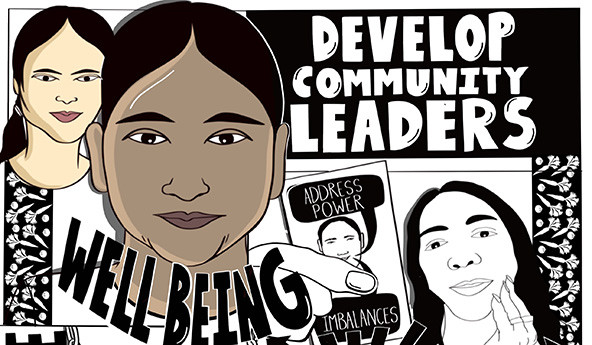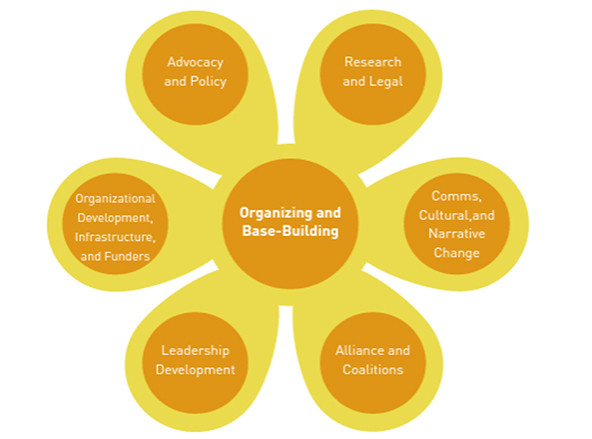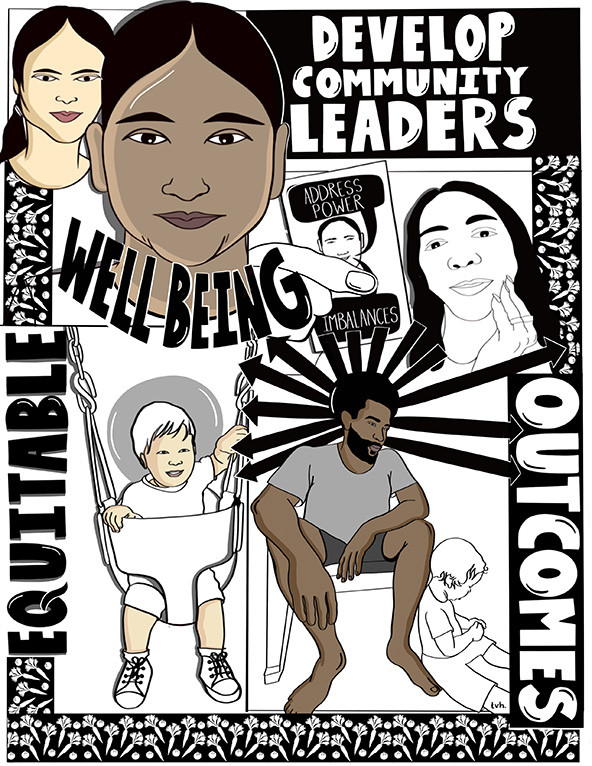 (Illustration by Taslim van Hattum)
(Illustration by Taslim van Hattum)
In seeking to improve the health outcomes of people in underserved communities, philanthropy’s results have, in general, been disappointing: Socioeconomic and racial injustices run so deep in these communities that strong barriers to change extend well beyond the health care system. It has become clear that only with deep, long-term investment from government and foundations can these communities hope to make meaningful progress in improving their residents’ health and well-being.
This kind of deep, long-term investment was what The California Endowment (TCE) had in mind when it launched its Building Healthy Communities (BHC) initiative in 2010, with the intention of investing $1.75 billion in 14 Californian communities over a span of 10 years. Starting from the idea that health disparities have underlying causes rooted in broader social and economic conditions, the foundation set four goals that it believed would lead to more equitable health outcomes:
- Provide a “health home” for all children in which they could count on consistent primary care
- Reverse the childhood obesity epidemic
- Increase school attendance
- Reduce youth violence

However, while the foundation was clear that BHC should not be a traditional “top-down” initiative—driven by foundation staff and professional consultants—and the theories of change developed to inform implementation reflected commitments to building community power and supporting community organizing—when BHC began it was still caught up in the traditional philanthropic model. TCE had set the initiative’s specific goals, and as quickly became clear, the foundation did not really cede control to the communities themselves: “Collaboration” meant funding professional advocacy groups, system leaders, and large service providers to seek input from the communities, mobilize community-member support, and advocate for increased and better-coordinated services. Most importantly, the initiative was focused on the policy-related goal of health equity, not greater community power.
Community grantees and residents had seen this model before and knew its faults. They told TCE that the initiative would be more successful if communities set their own goals and priorities, from the bottom up; it would work better if TCE made support of local community organizing groups its top priority, helped them build resident and community capacity, and strongly supported the recruitment and training of community leaders.
TCE listened. It deprioritized “grass-top” organizations and stepped back from driving the agenda. Led by local community organizers, BHC became a grassroots effort to build power for racial justice. At the foundation, this shift reflected the realization that building community power was not only an important means to an end but also an end in itself.
During its decade-long journey through Building Healthy Communities, TCE learned many lessons that continue to inform its approach to grantmaking and social change advocacy.
1. Inequity in community health and well-being stems from an imbalance in power that must be addressed head-on.
When BHC started, TCE believed that change would happen once decision makers became aware of community challenges. If individual community voices were lifted up, elected and appointed officials would listen and respond with policies, programming, and services that met the community’s needs. During the first few years, the program funded grantees to bring community residents to testify at government meetings and hearings, as well as inviting decision makers, system leaders, and residents to planning meetings where they shared their opinions and expressed priorities. The assumption was that the problem was a system in which some voices were heard and others not.
Community grantees knew better. They argued that to win policy changes, residents needed to counter entrenched opposing interests that had the power to monopolize attention and money. They had to battle structural racism and an unequal distribution of power. To fight the opposition and have a chance of winning, community members first had to organize as a group, identify their most pressing problems, understand root causes, create alternative proposals, and strategize how to win allies and neutralize opponents.
In short, they had to build their power. To accomplish this, money had to flow to organizations devoted to recruiting, training, and developing community leaders. The initiative needed to fund grassroots organizers and the institutions they had built.
TCE listened to this feedback, resolving to make “people power” more than empty rhetoric. It shifted funding from service organizations, public systems, and professional advocates to community organizers. After acknowledging a misalignment between its initial four goals and community members’ actual needs, TCE moved away from goals set in advance and stopped making distribution of grant dollars contingent on reaching specific goals. To allow community organizers and community priorities to lead the way, BHC planning meetings became a node for resident-led organizations to connect, build relationships, access resources, and collaboratively shape campaigns and initiatives around community-defined priorities.
2. Building power requires strategic collaboration among diverse organizations.
As TCE began to fund grassroots organizing, it realized that grassroots groups could begin to build adequate power only if they collaborated with one another and mustered the support of allies from diverse sectors and disciplines (e.g., policy and advocacy, research and legal assistance, communications and narrative change, leadership and organizational development). It was a matter not only of broadening the base of supporters and coordinating efforts but also of taking advantage of complementary knowledge, skills, and connections. Based on this realization, TCE shifted its emphasis and funding toward organizations that could work directly with grassroots organizing groups, support their networking efforts, and help counteract the push-back that would inevitably occur as previously underrepresented groups began exercising more voice and power in their communities.
The networked alliances of organizations that arose became known as power-building “ecosystems.” Using another metaphor from nature, the University of Southern California Equity Research Institute (USC ERI) developed a descriptive model that they dubbed the “power flower”: organizing and base-building groups form the flower’s center, and allies and partners from diverse disciplines connect to this center like a flower’s petals.

TCE and USC ERI were aiming to bring together allies from diverse sectors and disciplines and placing grassroots organizing groups at the center of the power flower -- prioritizing grassroots leadership of power building, instead of grass-tops and funders leading the efforts:
“During the first half of Building Healthy Communities, an emphasis has been on achieving health equity through professional advocacy and communications efforts bolstered by community voice and mobilization…The health equity equation should lead with community organizing, leadership development, and grassroots advocacy—and then bolster those efforts with professional advocacy and communications.” USC ERI
3. Healing is essential in movement work.
Just as those closest to the problems are the ones closest to the solutions, TCE began to understand that those closest to the problems are also those most scarred and traumatized by the systems they’re trying to change. The psychological, spiritual, and physical damage done to historically marginalized people’s bodies, souls, and minds over generations requires healing—not just out of compassion, but because those wounds are a barrier to change. Living under oppressive systems lowers self-esteem, saps motivation, destroys hope, and creates distorted psychological dynamics that can lead to community members turning on one another or self-destructing.
TCE tackled this issue by supporting a range of culturally rooted healing modalities integrated into shared political traditions. Key to this approach was rejecting the idea that people who need healing have something wrong with them that needs fixing; instead TCE focused on dismantling systems that harm people. Through the appropriate healing practices, the harms are named and acknowledged, creating space for reparation and community care. The process takes place at the individual, organizational, and collective levels simultaneously.
4. Changing public perceptions is key to power building.
At the start of the initiative, TCE took the lead on the design and rollout of public awareness campaigns, with for-profit communications consultants executing most of these campaigns. The results were inconsistent, however: In some places, the campaigns undercut or conflicted with messages from community partners, and most lacked formal mechanisms for engaging community partners.
Multiple rounds of feedback from partners led to significant changes. When foundations and communications stand back and allow community partners to control their own messaging, communicators could establish a shared language and vision with grassroots organizing partners. As a result, the stories and campaigns that developed would be grounded in power-building goals and create synergies between public perceptions, narrative change, and organizing work.
Following up on the lessons TCE learned about public relations and messaging during BHC, the foundation and its partners support the recruitment and training of a network of communications and narrative-change professionals who are rooted in historically marginalized communities and have knowledge and experience in working with grassroots organizers.
5. Power building requires that funders facilitate rather than lead.
To support effective bottom-up power building within communities, TCE had to fundamentally rethink the relationship of funder and grantees. This wasn’t simply a matter of relinquishing control over the course of the initiative. The foundation redefined how it measured success, how it communicated with grantees, and how it evaluated program managers. Instead of rewarding program managers and grantees for short-term policy wins, TCE invested in long-term power-building efforts that empower residents and strengthen leadership within the most impacted communities, knowing that policy losses might occur in the short term. As TCE redefined success, its goals shifted from minimizing harm by reforming systems to thoroughly transforming those systems. Foundation staff moved away from designing and branding campaigns that grantees would execute and toward roles as partners with grantees. Program managers, in turn, shifted from strengthening their favorite individual organizations one grant at a time to supporting and cultivating a robust movement ecosystem by funding organizations committed to working together over the long term.
A New Philosophy
 (Illustration by Taslim van Hattum)
(Illustration by Taslim van Hattum)
Through the lessons TCE learned with BHC, the foundation developed a new philosophy for its philanthropy. Instead of designing top-down initiatives that, at best, achieve minor gains in underserved communities and, at worst, maintain the status quo, it shifted to a model that builds power within communities from the ground up. This shift required a complete rethinking of foundation leadership, funding models, and communications strategies. Aiming to be a facilitator for growing power within communities, the foundation tries to foster strategic collaborations among grassroots and more established organizations and recognizes the essential value of promoting healing within communities. In the transfer of power from foundation leadership to the communities the foundation serves, TCE sees the potential for long-lasting, systemic change. It hopes that its work can serve as a model for a new wave of impact-driven philanthropy.
Building Healthy Communities has generated a broad and deep body of knowledge. More information about TCE’s decade of learning can be found here.
Support SSIR’s coverage of cross-sector solutions to global challenges.
Help us further the reach of innovative ideas. Donate today.
Read more stories by Tia Martinez.

